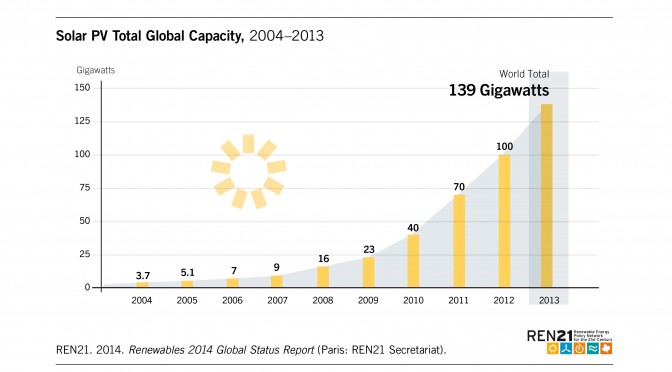If solar panels were people, they could start signing up for AARP memberships.
This year the commercial solar photovoltaic industry is celebrating its 60th birthday, after having been kicked off in 1954 by Bell Labs.
The birthday celebration was an oft-mentioned topic during the first day of one of the largest solar conferences in the U.S. on Monday in San Francisco. It’s the seventh year of the Intersolar North America conference, and this year the event is expected to bring in 27,000 attendees and exhibitors. On the opening night, California Governor Jerry Brown pointed out how far the solar industry has come since he first became Governor close to forty years ago, but also noted how far the industry still has to go to deliver enough clean energy to start to mitigate climate change.
It’s one of the brightest years for solar in U.S. history, as well as in some regions globally, as solar manufacturers have started to stabilize and thrive following massive price drop of previous years. As the Mayor of San Francisco, Ed Lee, noted Monday night, the price of solar cells has dropped by 80 percent over the last five years and close to 150,000 people in the U.S. are now employed by the solar industry (significantly more than coal-mining jobs). That includes 50,000 in California and 21,000 in the Bay Area.
And that trajectory is not just because of how cheap solar panels have become. Companies that launched new solar financing service business models can take much of the credit. Companies like SolarCity, SunEdison, Sungevity and Clean Power Finance have developed ways for solar customers to get deals for solar power, where they don’t have to pay upfront fees, but can pay for the electricity over a couple decades. That has opened up solar panels to a new wave of customers.
But now that solar makers have come through the pricing crunch and solar financiers have thrived, the industry is maturing and will begin to go through all those incremental upgrades and tiny tweaks that commodity industries face. The CTO of thin film solar leader First Solar, Raffi Garabedian, said in a talk Monday morning that he thinks the massive price drop (and margin erosion) of the past five years isn’t sustainable going forward, and the downward trend of solar pricing will flatten considerably.
Why? Because the access to ultra low cost capital, much of it provided by the Chinese government, for solar manufacturers won’t likely happen again any time soon. Now it’s time for incremental tech innovations to continue to lower the price of solar so that it becomes more competitive with fossil fuel power.
Some of those incremental innovations, which IHS analyst Jon Campos noted in a talk on Monday morning: solar wafer manufacturers are adopting diamond wire saws to cut wafers instead of steel wire saws. Diamond wires can slice wafers much more thinly, which means less material is used and wasted. Solar makers are also starting to adopt a newer type of solar base material, called n-type silicon, which lasts longer than the standard “p-type silicon.”
Applied Materials, which makes factory equipment for solar makers, is focused on making tools that can eek out efficiency from solar cells. With ultra low prices making the industry fiercely competitive, efficiency remains king for all those companies not focused on bottom-of-the-barrel pricing.
Applied also provides computer diagnostics for solar makers, which means it makes devices that can detect faulty solar wafers before they get used in a solar line. Which brings us to the area which doesn’t have to do with physics and chemistry, but largely with Moore’s Law.
IT computing systems — better diagnostics tools, better ways to reach customers directly, better customer control systems and big data algorithms that can make solar deployment easier — will continue to help solar inch down this cost curve and up the efficiency curve. IT will be one of the main drivers to reduce the so-called “soft costs of solar” — everything that doesn’t have to do with the hardware. Soft costs can make up more than half of the cost of a solar panel system.
At the same time that the huge price drop in solar is set to flatten out a bit, the need for clean energy to help fight climate change is becoming ever more prominent. The U.S. is finally setting some of its most aggressive policies to date, with the EPA set to regulate power plant emissions for existing and new plants. Japan is looking to solar to help solve its rising carbon emissions after taking its nuclear plants offline. And India wants to meet its national high solar targets.
Solar has emerged as the most promising clean energy technology, at a time when it’s never been needed more. But as Governor Brown noted, solar has a long way to go before it makes a major dent in the world’s electricity makeup. So now we need all the scientists, researchers, engineers and business and policy folks to brainstorm the tiny, incremental improvements that together can make solar a meaningful and massive industry.
By
http://gigaom.com


